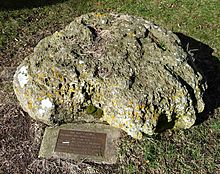|
|
|
|
WhittlestoneStanding Stone / Menhir
|
||||||||||||||||||||||||
|
|
|
Images (click to view fullsize) |
|










|
Fieldnotes |
|
|
Visited 6.8.11 The Whittlestone can be found on the green between the bus stop and the appropriately named Whittlestone Close, next to the village hall? The stone is about 1 ft high and 3 ft across. The information plaque states that the stone originally stood 200 yards from the church before being moved to its current position. Not much to see but worth a look when passing through. |
Posted by CARL 8th August 2011ce |
| Arrived from The Horestone on 6.3.2009. The Whittlestone sits in a landscape made up of a refuse bin, a flag pole (with St George's Flag), a Jubilee commemoration bench and a neat stone building which appears to be a public building (I couldn't work out what). Lower Swell is a nice village, but sadly the Whittlestone doesn't add much. I sat on the Jubilee bench for a few minutes and then headed west towards Lower Swell long barrow. As you leave the village, the two new developments on the road out are called Whittlestone Close and Whittlestone Hollow, so at least there is some acknowledgement of the oldest piece of the village's history amongst the Little England-isms. |
 Posted by thesweetcheat
Posted by thesweetcheat7th March 2009ce Edited 7th March 2009ce |
|
Bang slap in the middle of Lower Swell village the Whittlestone lies dead. Were it not for the little brass plaque revealing its neolithic origins you would be forgiven for mistaking it for something the bin men forgot. It's not pretty, but it is big and thick, too, and it's recorded to have been shifted here at some point in the recent past. Dumped, more like. Given its proximity to Lower Swell long barrow, it may well have been part of that. This post appears as part of the weblog entry Four long barrows and a funeral
|
 Posted by Jane
Posted by Jane26th January 2004ce Edited 27th January 2004ce |
Folklore |
|
Nether Swell. -- Within a stone's throw from the north-west angle of the church, on the summit of the rising ground, in the allotments, stood, within the memory of the writer of this paper, a familiar, yet most venerable monolith. It was known as the Whistlestone (so called, perhaps, from this, the Wheat Hill, as the one beyond was the Oat Hill). This stone was the last, most probably, of a cist. Many stones were found at its base.From v7 of the Transactions of the Bristol and Gloucestershire Archaeological Society (1882/3), in a piece by the Rev. David Royce about an excursion to Stow on the Wold. |
 Posted by Rhiannon
Posted by Rhiannon22nd August 2010ce Edited 22nd August 2010ce |
Miscellaneous |
|
|
Details of stone on Pastscape (SP 17242581) Whittlestone or Whistlestone (NR) (Site of) (1) The Whistlestone was probably the last remnant of a burial-chamber as human bones were found beneath it in the mid-19th century. (2) (SP 17322529) Removed to the vicarage paddock. A much weathered irregular-shaped stone 1.4m by 1.0m and 0.4m thick stands at SP 17302534 in the NW corner of the vicarage paddock. The vicar confirms that this is the stone known as the Whittlestone. Surveyed at 1:2500. Stone moved c.1978 to outside the village hall. (3-6) |
 Posted by Chance
Posted by Chance11th April 2016ce |
|
From "Companion into Gloucestershire" - R.P. Beckinsale (1947 5th edition Methuen): "The churchyard [at Lower Swell] actually encloses a small tumulus, and about ninety years ago, when the soil was being levelled for the foundations of the new nave, evidences of frequent early cremations were discovered. At the same time, a monolith, known locally as the Whitlestone or Whittlestone, which stood a few furlongs to the north of the church, was hauled down, and many bones were found at its base. The stone, which no doubt formed the only surviving fragment of a Long Barrow, has been preserved in the vicarage paddock. The Horestone, a similar monument, still stands in a ploughed field half a mile from Lower Swell on the right-hand side of the pretty road to Upper Slaughter." |
 Posted by thesweetcheat
Posted by thesweetcheat8th February 2009ce |
| Despite the story that it can't be shifted, actually it has been moved, probably several times. Originally at SP172258 it was part of a chambered barrow, and bones were found under it in the 19th century. In 1880 someone (presumably the vicar) took it upon themselves to move it to the paddock of Lower Swell vicarage (SP173253). And judging by baza's photos it looks as though it's been moved yet again? |
 Posted by Rhiannon
Posted by Rhiannon4th September 2003ce Edited 22nd August 2010ce |

